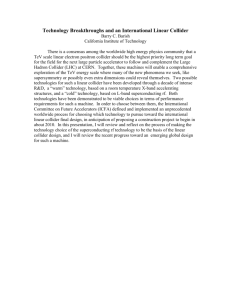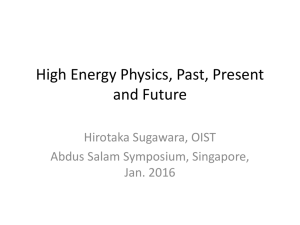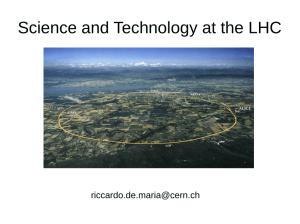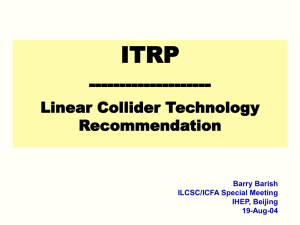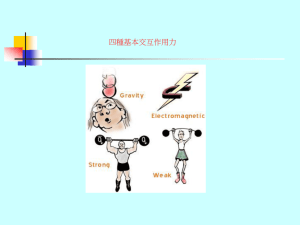p24-dorfan
advertisement
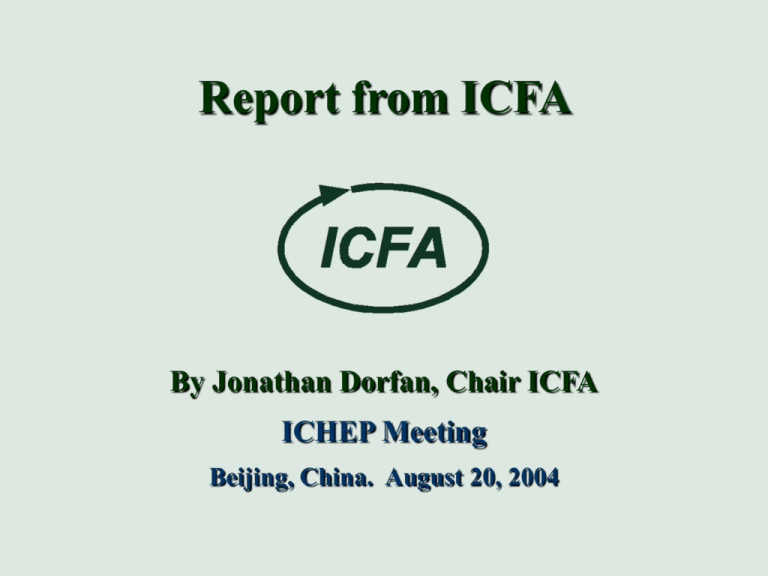
Report from ICFA By Jonathan Dorfan, Chair ICFA ICHEP Meeting Beijing, China. August 20, 2004 The Role of ICFA Charter and Aegis ICFA, the International Committee for Future Accelerators, was created to facilitate international collaboration in the construction and use of accelerators for high energy physics. It was created in 1976 by the International Union of Pure and Applied Physics. Its purposes, as stated in 1985, are as follows: To promote international collaboration in all phases of the construction and exploitation of very high energy accelerators To organize regularly world-inclusive meetings for the exchange of information on future plans for regional facilities and for the formulation of advice on joint studies and uses To organize workshops for the study of problems related to super highenergy accelerator complexes and their international exploitation and to foster research and development of necessary technology For more info see: http://www.fnal.gov/directorate/icfa/ ICFA MEMBERSHIP June 2004 Canada R. Keeler CERN Member States B. Foster R. Aymar A. Wagner China H. Chen Japan S. Komamiya Y. Totsuka Russia V. Rubakov Y. Tikhonov USA J. Dorfan (Chair) M. Witherell S. Dawson Other Countries C. Garcia Canal P. Singer D. Son C11 V. Lüth (Secretariat: R. Rubinstein, B. Beuaseroy) Global Planning and Cooperation ― A Must for HEP Never before has a field of science attempted to globalize itself as extensively as HEP has done recently. It is a challenging task, but one that we must do successfully. Indeed the long-term health of the field depends critically on truly global cooperation The necessity for global coordination was formalized by ICFA in its May 1993 ICFA Statement entitled “International Collaboration in the Construction of Future Large Accelerator Projects”. ICFA’s role was important for the ultimate realization of a global LHC and is crucial for launching the Linear Collider ICFA and the Linear Collider ICFA has been helping guide international cooperation on the Linear Colider since the mid 1990’s. Major steps: 1995: First ILC TRC Report, under Greg Loew as Chair 1999: ICFA Statement on Linear Collider 2002: ICFA commissioned the second ILC TRC Report, under Greg Loew as Chair 2002: ICFA establishes the International Linear Collider Steering Group (ILCSC) with Maury Tigner as Chair International Technology Recommendation Panel (ITRP) The next major step towards the realization of a global linear collider is the creation of an internationally-federated design team. The ILCSC is in the midst of establishing such a team A critical prerequisite for starting the work of the global design team is the requirement of a single option for the RF technology to power the main linacs ICFA formed the International Technology Recommendation Panel (ITRP) to recommend the optimal choice of RF technology International Technology Recommendation Panel (ITRP) Jean-Eudes Augustin Jonathan Bagger Barry Barish (Chair) Giorgio Bellettini Paul Grannis Norbert Holtkamp George Kalmus Gyung-Soo Lee Akira Masaike Katsunobu Oide Volker Soergel Hirotaka Sugawara Yesterday, the ILCSC and ICFA met to review the ITRP recommendation. ITRP Chair made a presentation accompanied by a 2.5 page Executive Summary that encapsulates the recommendation ICFA/ILCSC unanimously endorsed the recommendation ITRP -------------------Linear Collider Technology Recommendation Barry Barish ILCSC/ICFA Special Meeting IHEP, Beijing 19-Aug-04 Departing from Korea Why Decide Technology Now? We have an embarrassment of riches !!!! Two alternate designs -- “warm” and “cold” have come to the stage where the show stoppers have been eliminated and the concepts are well understood. R & D is very expensive (especially D) and to move to the “next step” (being ready to construct such a machine within about 5 years) will require more money and a concentration of resources, organization and a worldwide effort. It is too expensive and too wasteful to try to do this for both technologies. A major step toward a decision to construct a new machine will be enabled by uniting behind one technology, followed by a making a final global design based on the recommended technology. The final construction decision in ~5 years will be able to fully take into account early LHC and other physics developments. The Charge to the International Technology Recommendation Panel General Considerations The International Technology Recommendation Panel (the Panel) should recommend a Linear Collider (LC) technology to the International Linear Collider Steering Committee (ILCSC). On the assumption that a linear collider construction commences before 2010 and given the assessment by the ITRC that both TESLA and JLC-X/NLC have rather mature conceptual designs, the choice should be between these two designs. If necessary, a solution incorporating C-band technology should be evaluated. Note -- We have interpreted our charge as being to recommend a technology, rather than choose a design How ITRP has Approached its Task Six Meetings RAL (Jan 27,28 2004) DESY (April 5,6 2004) SLAC (April 26,27 2004) KEK (May 25,26 2004) Caltech (June 28,29,30 2004) Korea (August 11,12,13) Tutorial and Planning Site Visits Deliberations Conclusion Evaluating the Criteria Matrix We analyzed the technology choice through studying a matrix having six general categories with specific items under each: the scope and parameters specified by the ILCSC; technical issues; cost issues; schedule issues; physics operation issues; and more general considerations that reflect the impact of the LC on science, technology and society We evaluated each of these categories with the help of answers to our “questions to the proponents,” internal assignments and reviews, plus our own discussions What did we do? We each traveled at least 75,000 miles We read approximately 3000 pages We had continuing interactions with the community and with each other We gave up a good part of our “normal day jobs” for about six months We had almost 100% attendance by all members at all meetings We worked incredibly hard to “turn over every rock” we could find. The Recommendation We recommend that the linear collider be based on superconducting rf technology (from Exec. Summary) This recommendation is made with the understanding that we are recommending a technology, not a design. We expect the final design to be developed by a team drawn from the combined warm and cold linear collider communities, taking full advantage of the experience and expertise of both (from the Executive Summary). We submit the Executive Summary today to ILCSC & ICFA Details of the assessment will be presented in the body of the ITRP report to be published around mid September The superconducting technology has features that tipped the balance in its favor. They follow in part from the low rf frequency. Some of the Features of SC Technology The large cavity aperture and long bunch interval reduce the complexity of operations, reduce the sensitivity to ground motion, permit inter-bunch feedback and may enable increased beam current. The main linac rf systems, the single largest technical cost elements, are of comparatively lower risk. The construction of the superconducting XFEL free electron laser will provide prototypes and test many aspects of the linac. The industrialization of most major components of the linac is underway. The use of superconducting cavities significantly reduces power consumption. Both technologies have wider impact beyond particle physics. The superconducting rf technology has applications in other fields of accelerator-based research, while the X-band rf technology has applications in medicine and other areas. Remarks and Next Steps CLIC, C-Band, GLC/NLC and TESLA researchers have done a fantastic job bringing these technologies to the point where we can move forward toward making a next generation linear collider a reality. We especially want to note the importance of the the work that has been done on the warm technology. We need to fully capitalize on the experience from SLC, FFTB, ATF and TTF as we move forward. The range of systems from sources to beam delivery in a LC is so broad that an optimized design can only emerge by pooling the expertise of all participants. We endorse the effort now underway to establish an international model for the design, engineering, industrialization and construction of the linear collider. Formulating that model in consultation with governments is an immediate priority. Strong central management will be critical from the beginning. Remarks and Next Steps The linear collider will be designed to begin operation at 500 GeV, with a capability for an upgrade to about 1 TeV, as the physics requires. This capability is an essential feature of the design. Therefore we urge that part of the global R&D and design effort be focused on increasing the ultimate collider energy to the maximum extent feasible. (from Exec Summary) A TeV scale electron-positron linear collider is an essential part of a grand adventure that will provide new insights into the structure of space, time, matter and energy. We believe that the technology for achieving this goal is now in hand, and that the prospects for its success are extraordinarily bright. (from Exec Summary) Next Steps for ICFA….Global Design Initiative ICFA’s endorsement is accompanied by a Press Release which can be found, along with the ITRP Executive Summary, at http://www.interactions.org/cms/ The Press Release expresses the total unanimity of support from all the worldwide partners for moving forward together with an internationally federated design using the superconducting technology for the main linac rf Qoutes taken from the Press Release Scientific discovery is the goal, SLAC Director Dorfan emphasized. “Getting to the physics is the priority,” ….. “The panel was presented with two viable technologies. This decision expedites the preparations that could ultimately permit mining the exciting science. We at SLAC embrace the decision and look forward to working with our international partners.” DESY Director Albrecht Wagner cited the achievement of an important milestone. "With this decision,” ….. “particle physics has made a major step forward toward the future. The worldwide community of particle physicists can be proud that one of the two viable technologies has now been selected for the design of this global project, independent of its final location.“ "This decision is a significant step to bring the Linear Collider project forward," KEK's Director General Yoji Totsuka said. "The Japanese high-energy community is happy with the decision and is willing to participate in the truly global project.“ “With the technology decision behind us,” Fermilab Director Michael Witherell said, “the particle physics community can now begin work on a global design for a linear collider. ……. There are many steps ahead of us before an international linear collider becomes a reality, but today’s announcement of the technology choice provides an important focus.” CERN Director General Robert Aymar commented on progress toward an international linear collider design. “A linear collider is the next logical step to complement the discoveries that will be made at the LHC, “………”The technology choice is an important step in the path towards an efficient development of the international TeV linear collider design, in which CERN will participate.” We Live in Extraordinary Times Just as it did with the LHC in the 1990’s, ICFA has a very strong focus on facilitating the wishes of the worldwide HEP community – in this era of the 2000’s it is to establish a fully international TeV Linear Collider At no time in the history of particle physics has the scientific landscape presented us with such an exciting spectrum of unanswered questions! The LHC will make major discoveries that challenge that agenda, but to engage the fullness of the scientific quest will take discoveries from a companion TeV Linear Collider The stage is now set to proceed forward to realize expeditiously an international design for a TeV linear collider…………. …..ICFA encourages the internatioanl HEP community to unify enthusiastically in support of this exciting mission
